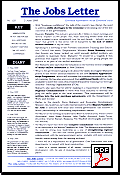



|
 |

|
| No.197 | 28 November 2003 | Essential Information on an Essential Issue |
of key events over the last few weeks. UNEMPLOYMENT DROPS TO 4.4% WHO GOT THE JOBS?
COSTELLO: OZ CLOSE TO “FULL EMPLOYMENT” FOUR WEEKS ANNUAL LEAVE, STARTING 2007 CEG CAUGHT UP IN AWATERE HUATA PROBLEMS WORKINSIGHT MAYORS WANT INPUT INTO SCHOOL REVIEWS PSA ON THE FUTURE OF WORK THE FUTURE OF ADULTHOOD LEAVE NO YOUNG PERSON BEHIND CONNECTIONS — A COMMITMENT TO YOUNG PEOPLE PUBLIC SERVICE CADETS  LAST Letter
LAST Letter
NEXT Letter   Download this issue as a PDF file
Index to Features
30 October 2003The most sought after characteristic that employers seek in a tertiary graduate is strong verbal and interpersonal communication skills, according to a Victoria University survey. The NZ University Students Association releases Student Support: The Real Story. Co-president Fleur Fitzsimons says the report provides a balance to the government's "one-sided" review published earlier. Download (PDF, 36 pg, 4.1mb) from www.students.org.nz/campaigns.htm About 1,500 Telstra jobs will be lost to India as the Australian telecommunications company out sources more of its technical operations. 31 October 2003Small businesses should be allowed to take-on new employees on a one-month assessment/probation period, according to Minister of Small Business John Tamihere. Electronic Data Systems, the world's second biggest seller of computer services is to cut 2,500 more jobs, primarily in the northern hemisphere. EDS New Zealand says it is too early to say what effect, if any, this would have on the local operation. 2 November 2003An Employment Court decision that a film industry worker was an employee, rather than a contractor, may have "significant consequences that are unfortunate for the film industry", according to Lord of the Rings producer Barry Osborne. The decision clears the way for a Wellington model-maker to take a personal grievance against his previous Rings-related employer for alleged unjustifiable dismissal. National Party leader Don Brash eliminates the party's shadow Women's Affairs position and says he would like to abolish the Ministry of Women's Affairs. Brash creates a new position of speaker on Asian Relationships. 3 November 2003Three South Island councils, who sent representatives to the "Opportunity New Zealand" exposition in London, receive over 400 inquiries from skilled British workers showing interest in relocating to their areas. 4 November 2003The Serious Fraud Office brings charges against ACT MP Donna Awatere Huata for allegedly misusing public money granted to organisations she was associated with. Over the last quarter, the US economy has experienced the fastest expansion since 1984. However, The Wall Street Journal says few economists expect much of a drop in unemployment because many companies are squeezing more productivity out of their existing workforce. 5 November 2003Twenty-eight new jobs will be created in Wanganui as carpet manufacturer Cavalier Corporation adds a new processing line. An increase in social spending appears to be likely next year after Treasury announces that the government is running $1.2 billion ahead of budget. Minister of Finance Michael Cullen says social spending could increase by $500 million each year for the next two years. The euro zone unemployment rate is 8.5%. 6 November 2003Australia's unemployment drops to a 14-year low of 5.6%. During October, full-time job numbers rose by nearly 20,000 and the number of part-time jobs numbers increased by nearly 50,000. 7 November 2003The Child Poverty Action Group renews it calls to the government to make the Child Tax Credit available to all low-income families, and to fully adjust levels and thresholds of family assistance to catch up what has been lost to inflation since 1986. The US Reserve Bank says it will not begin to lift interest rates, even though domestic spending pushed the economy ahead at an annual rate of 7.2%. Chairman Alan Greenspan says that unless hiring picks up and lay-offs ease, the domestic spending spree could be short lived. 9 November 2003A critical shortage of building inspectors could make proposed legislation, designed to combat the "leaky building" problem, unworkable. The government wants to require more building inspection input from councils. But most building inspectors are 40-65 years and with the scrapping of the traditional apprenticeship schemes, there are few young ones coming through. Wellington City Council's George Skimmings says that his council is already struggling to find suitably qualified consents officers. Skimmings: "The new accreditation programme means more training and more officers across the board. And we don't know where they're going to come from." The ACT Party expels Donna Awatere Huata. 10 November 2003The Green Party says that rural families and communities will pay a high price if the government presses ahead with plans to close 300 small schools, Green MP Metiria Turei: "The Education Ministry's insistence on a 160 pupil minimum for all schools will destroy the fabric of rural communities. Local rural schools are community resources, supported by years of fundraising in their district. The Ministry's planned closures amount to an act of theft from rural families and children." On average, 110 more people move to live in the Auckland region each day, according to Statistics NZ. 70% of the country's immigrants settle in Auckland. 11 November 2003The NZ unemployment rate is 4.4%, the lowest level for 16 years. Wages rose at an annual rate of 2.3%, according to Statistics NZ. This is slightly ahead of inflation (1.5%) but Westpac economist Nick Tufley says the current wage levels do not present a significant threat to inflation. At least 150 jobs have been lost in the Bay of Plenty as companies who had geared up for a "wall of wood" have seen forestry industry production diminish. Sawmills, transport operators and portside marshalling companies are shedding dozens of staff. 12 November 2003The WTO has cleared the way for the EU and Japan to impose trade sanctions on the US in retaliation for illegally imposed tariffs on steel. The EU has readied a list of American imported products (valued at $US2.2 billion) to be targeted for extra tariffs that could be enacted by mid-December. 13 November 2003The Association for Migration and Investment gives a "cautious welcome" to the government's new points system for skilled immigrants. Chairman Bill Milnes says that making residency easier to achieve by those who are strong on practical experience but short on tertiary qualifications would benefit the economy. US-based General Motors is to export thousands of new cars, including Cadillac luxury models, to China in 2004 and 2005. The cars will be in the form of both complete vehicles and kits for assembly. 16 November 2003Fewer timber workers are likely to be needed in the central North Island as Carter Holt Harvey continues to scale back its annual harvest. The company plans to continue to reduce the harvest each year through to 2005. More than 50 highly trained NZ "live-wire" electricity workers have left the country and are working in Ireland. Unionists and industry operators alike fear that more may follow in a global labour poaching war, especially if the US begins to look further afield for workers to repair its neglected electricity network. The Aviation Industry Association says the aviation industry will experience a shortage of airplane pilots by 2005 after the government puts a limit og 130 on the number of student pilot places it will fund. Association chairwoman Irene King says that each year, for the past decade, about 300 pilots had entered the industry. King says the drop in pilot graduates comes at a time of unprecedented industry demand. 18 November 2003Nearly 100 staff of Hamner Clinics Ltd will lose their jobs as the company, which ran the country's only residential drug and alcohol treatment centre, as well as five out patient clinics, closes down. 19 November 2003NZ expands its working holiday visa scheme from 25,000 to 31,000. The scheme allows young people from countries who offer reciprocal arrangements a one-year working visa in NZ. More immigrant fruit industry contractors will be investigated for tax evasion after one man is jailed for the offence. The tax department estimates the Western Bay of Plenty has lost $14 million in taxes over the last two years by some tax dodging horticultural contractors failing to submit PAYE taxes. 21 November 2003130 jobs will be lost as Carter Holt Harvey plans to close its sawmill and part of its re-manufacturing plant in Tokoroa.
 LAST Diary
LAST Diary
NEXT Diary 
|
UNEMPLOYMENT DROPS TO 4.4%Employment levels are also up. Statistics New Zealand says that while gains in permanent and long-term immigration has fed the employment growth, it is not just new immigrants who are getting the jobs. An increased demand for workers has also drawn people into the work force who have either been unemployed or who had been out of the labour force. We include our regular Statistics That Matter summary in this issue of The Jobs Letter. Some highlights: — There were 26,000 jobs added to the economy over the last quarter. Much of this employment growth was in Auckland. — Female employment grew greater than the overall employment rate. There were significant increases in the number of women employed in construction and in the transport, storage and communications industries. — The number of unemployed people fell by 6,000 over the quarter. The number of unemployed people fell by 19,000 over the past year. — The unemployment rate has dropped for all ethnic groups. Compared to this time last year, Maori unemployment is down from 12% to 9.7%; the Pacific rate is down from 9.3% to 6.6%; and the Pakeha rate is down from 3.8% to 3.3%. — Not everyone who left the unemployment lines has necessarily found a job. Statistics NZ reports that there are 22,000 more people "not in the labour force" than there were at this time last year. Source—Statistics NZ 11 November 2003 "Household Labour Force Survey September 2003 quarter"; The Independent 12 November 2003 "Hiring hots up, jobless numbers fall" by Bob Edlin; New Zealand Herald 12 November 2003 "Unemployed rate at 16-year low" by Brian FallowWHO GOT THE JOBS?Of the 218,000 new jobs created since this period of job expansion began in June 1998, only 27,500 or 13% of these have gone to people under 25 years. Most of the new jobs (71%) have gone to people over 45 years. — We've taken a closer look at "Who's got the Jobs" on the website version of our Statistics That Matter feature. Source—Statistics New Zealand "Household Labour Force Survey: September 2003 quarter"
COSTELLO: OZ CLOSE TO "FULL EMPLOYMENT" The Australian unemployment rate has also fallen — to 5.6%, the lowest unemployment
level across the Tasman in 22 years. Treasurer Peter Costello says this rate is near to "full employment"
and he believes that nearly every Australian who wants a job can now get one. Costello is hopeful that
the rate could yet drop to 5% ... and he has reassured business leaders that this unemployment level is
not expected to push up the cost of wages. The Australian unemployment rate has also fallen — to 5.6%, the lowest unemployment
level across the Tasman in 22 years. Treasurer Peter Costello says this rate is near to "full employment"
and he believes that nearly every Australian who wants a job can now get one. Costello is hopeful that
the rate could yet drop to 5% ... and he has reassured business leaders that this unemployment level is
not expected to push up the cost of wages.
Colebatch points out that when you add the numbers of people officially unemployed to those "underemployed"(working part-time but wanting more work), plus the "discouraged jobseekers" (mostly over-45s who had given up job-hunting), and those who are actively looking for work but not counted as unemployed ... then about 1,872,500 Australians want to work, but have none or have too little of it. Colebatch: "An astonishingly large number of Australians remain without work. But worse: an astonishingly large number of Australian families remain without work. Almost one-in-six Australian children now live in households where no one has a job. " — Source—The Sydney Morning Herald 10 November 2003 "Jobs for all, promises Costello" by Matt Wade; The Age 18 November 2003 "Memo Treasurer: how to tackle unemployment" by Tim Colebatch, economic editorNEW JOBS ARE PART-TIMEBut there has been a decrease in the number of full-time jobs for labourers, clerical, sales, service, production and transport workers over the last three years. For these workers, the new jobs have been part-time, usually on a casual basis and poorly-paid. Since the 1990 recession, almost two-thirds of all jobs created in Australia — more than 1 million out of 1.6 million — have been part-time. In 13 years, full-time jobs have grown just 9%, whereas the number of part-time jobs has shot up by a staggering 62%. Sue Richardson, director of the National Institute of Labour Studies at Flinders University, says Australia stands out among Western countries for the way part-time jobs dominated job growth. Richardson: "It appears to be largely employer-driven, and in service industries where employers want employees there just when they most need them." The figures show the dominance of part-time jobs since 2000 is not the workers' choice. Of the 199,000 net growth in women working part-time, 107,000 wanted to work more hours — usually full-time — and 65,000 were actively looking for more work. Source—The Age 4 October 2003 "Part-time work dominates national job gains" by Tom ColebatchFOUR WEEKS ANNUAL LEAVE, STARTING 2007 All New Zealand workers will be entitled to a minimum of four weeks annual leave from
April 2007. PM Helen Clark says that the extra week will be good for working parents and it will
correct equity issues between white collar workers — many of whom already enjoy fours weeks leave —
and manual workers who generally don't. She also says that it will also help New Zealand compete
internationally to attract and retain skilled people. Australia has had four weeks annual leave for the past
30 years. All New Zealand workers will be entitled to a minimum of four weeks annual leave from
April 2007. PM Helen Clark says that the extra week will be good for working parents and it will
correct equity issues between white collar workers — many of whom already enjoy fours weeks leave —
and manual workers who generally don't. She also says that it will also help New Zealand compete
internationally to attract and retain skilled people. Australia has had four weeks annual leave for the past
30 years.
The three-and-a-half year advanced notice of the change is supposed to give employers, and the government, time to plan for the change. Treasury has estimated the cost of the extra week will be $350 million or an additional 1% of the private sector annual wage bill. Source—Press Statement from the Office of the Prime Minister 10 November 2003 All workers to enjoy four weeks annual leave"; Press Release National Party 10 November 2003 "Workers will have to pay for extra week's holiday"CEG CAUGHT UP IN AWATERE HUATA PROBLEMSThe Auditor-General's report is the result of a nine-month investigation into nearly $2 million in grants made to organisations Awatere Huata had been associated with since her election to Parliament in 1996. The grants were provided primarily by the Ministry of Education, CEG and Te Puni Kokiri. The report says that, in many instances, all three government agencies did not follow their stated funding policies and procedures, and poorly performed contract monitoring and management.  Minister of State Services Trevor Mallard was quick to lay the blame on the previous
National-led government. However, The New Zealand
Herald points out that at the time that the $40,000
CEG grant was made, the current Minister of Maori Affairs, Parekura Horomia, was the General Manager
of the Community Employment Group. Two other Awatere Huata-related grants were made
during Horomia's tenure at CEG, one of which officials have been unable to find the contract file or a copy
of the letter of agreement. Minister of State Services Trevor Mallard was quick to lay the blame on the previous
National-led government. However, The New Zealand
Herald points out that at the time that the $40,000
CEG grant was made, the current Minister of Maori Affairs, Parekura Horomia, was the General Manager
of the Community Employment Group. Two other Awatere Huata-related grants were made
during Horomia's tenure at CEG, one of which officials have been unable to find the contract file or a copy
of the letter of agreement.
The Herald reports that the Huata couple had a "pushy" reputation in dealing with government funding agencies. Education officials told of being called "almost daily" at some points by Mrs Awatere Huata over contracts and being "threatened" with her going to the Minister if they would not agree with contract terms. One official admitted offering a contract at the top-end rate due to the "negotiating style" of the couple. Trevor Mallard says that it got to the point where officials were so scared of Mr Huata they would not meet with him alone because of the threatening nature of his approaches. — Inquiry into Public Funding of Organisations Associated with Donna Awatere Huata MP, a report of the Controller and Auditor-General, (November 2003) ISBN 0-478-18111-6 - can be downloaded here (PDF 152pg, 1.936Mb) Source—The Auditor General's report November 2003; The Dominion Post 7 November 2003 "Ministries blasted in Huata audit" by Nick Venter; New Zealand Herald 8 November 2003 Horomia oversaw $137,500 in grants to Huata projects" by Fran O'Sullivan; Weekend Herald 8-9 November 2003 "Pushy coup-le feared by officials" by Ruth Berry; New Zealand Herald 11 November 2003 PM wants code of conduct for MPs" by Audrey YoungWORKINSIGHT
Source—Email from Robert Heyes 18 November 2003MAYORS WANT INPUT INTO SCHOOL REVIEWS Many Mayors involved with the Taskforce for Jobs are concerned about the government
reviews that could result in the closure or merger of as many as 300 small schools. The Taskforce goal
is to see that no young person under 25 years is out of work or training in our communities, and
chairperson Garry Moore from Christchurch points out that closing schools, particularly in a small rural
communities, impacts on the wider employment environment and can even jeopardize the economic viability
of a region. Many Mayors involved with the Taskforce for Jobs are concerned about the government
reviews that could result in the closure or merger of as many as 300 small schools. The Taskforce goal
is to see that no young person under 25 years is out of work or training in our communities, and
chairperson Garry Moore from Christchurch points out that closing schools, particularly in a small rural
communities, impacts on the wider employment environment and can even jeopardize the economic viability
of a region.
Moore has written to the Minister of Education, Trevor Mallard, and asked him to ensure that the school reviews will take into consideration the planned future economic development of each area. Councils and economic development agencies — through their work with business and through their planning and consents processes — hold an enormous amount of information that is relevant to the school reviews. Moore: "Such information must be an integral part of these reviews and should be placed in the context of region-wide activity regarding population growth, innovation and business investment strategies." Source— Letter from Garry Moore to Trevor Mallard 24 November 2003
PSA ON THE FUTURE OF WORK The NZ Public Service Association chose
"Working the Future" as this year's theme for
its annual conference of union delegates. The PSA brought out several leading international thinkers
and researchers on the future of work, and focussed on how changing working trends will effect the
public sector. The conference was held at Victoria University November 4-6, and was designed as an
innovative and interactive experience covering a wide variety of issues from how workers can prepare
themselves for an uncertain working future, how to achieve work/life balance, the impact of an
ageing workforce, and how to cope with new technology and globalisation. The NZ Public Service Association chose
"Working the Future" as this year's theme for
its annual conference of union delegates. The PSA brought out several leading international thinkers
and researchers on the future of work, and focussed on how changing working trends will effect the
public sector. The conference was held at Victoria University November 4-6, and was designed as an
innovative and interactive experience covering a wide variety of issues from how workers can prepare
themselves for an uncertain working future, how to achieve work/life balance, the impact of an
ageing workforce, and how to cope with new technology and globalisation.
The PSA says that, in recent years, the union movement has learned some hard lessons on workplace change. The drive during the 1990s to make public services more efficient and effective has come with very mixed results. The union believes that "ideologues" had almost total control over the process of change, allowing them to fully replicate private sector methods in the public service: "The union movement tried to apply the brakes, whereas we should have been disputing the steerage ... There is now a general consensus that privatisation has not delivered (nor even maintained) quality public services." The PSA recognises that this process of workplace change has an ongoing momentum, and it argues that the union movement and the State must reclaim their roles as "critical drivers" in the economy, and keep focussing on how they can shape and influence the way the public service works in the future. — The PSA "Working the Future" webpage is at www.psa.org.nz/futurework.asp  Heading the international speakers at the PSA conference was Bani Dheer, a Canadian
academic who has worked with public and private sectors in creating recruitment and retention strategies to
target young employees. Dheer has recently written
The Future of Work: How The Shift From
Materialism To Meaning Will Change The Way We Live And
Work (to be published by Penguin Books in
2004). In the book she identifies trends shaping the future workplace, and focuses on the increasing
demand among 20 year olds and 50 year olds alike for more meaningful work in their lives. Heading the international speakers at the PSA conference was Bani Dheer, a Canadian
academic who has worked with public and private sectors in creating recruitment and retention strategies to
target young employees. Dheer has recently written
The Future of Work: How The Shift From
Materialism To Meaning Will Change The Way We Live And
Work (to be published by Penguin Books in
2004). In the book she identifies trends shaping the future workplace, and focuses on the increasing
demand among 20 year olds and 50 year olds alike for more meaningful work in their lives.
Dheer: "The great challenge of the upcoming century is not the struggle to make ends meet but the struggle to define what the ends should be. It is not the monotonous hum of the machinery getting us down, but the endless array of choices complicated by the lightning speed of information that sets our teeth on edge. To those of us in the trenches, having to choose between options that may facilitate or destroy the kind of lives we want our work to help us create, is no less agonizing than the eighteenth century factory worker — just different." Source—The Jobs Letter editor Vivian Hutchinson attended the PSA conference as a guest.THE FUTURE OF ADULTHOOD Professor Johanna Wyn from the University of Melbourne told the PSA conference that there
is evidence that the transitions into adulthood for the post-1970 generation have differed in
significant ways from the previous generation. And she warns that in most Western countries, there is a
mismatch between the changing life patterns of young people and an educational policy that is based on a
linear progression from school to work. Professor Johanna Wyn from the University of Melbourne told the PSA conference that there
is evidence that the transitions into adulthood for the post-1970 generation have differed in
significant ways from the previous generation. And she warns that in most Western countries, there is a
mismatch between the changing life patterns of young people and an educational policy that is based on a
linear progression from school to work.
The University of Melbourne's Youth Research Centre has undertaken a "Life-Patterns" study of school leavers, which since 1991 has followed 800 tertiary-qualified young people through their life and work. This is the first wave of school leavers who have known no other world than the post-1980s deregulated economy. The Melbourne research has shown that, for these young people, the traditional `linear' path through education and training is not the majority experience. The study has found that even the best-educated young people have changed jobs or careers in the past five years. Only 18% have had one job since 1996; a majority (61%) had held between two and four jobs in that time; and a very mobile 20% have had more than five jobs. Almost half of the group expected to change jobs again in the next year or two. And interestingly, more than a third of the young people were still "single and unattached" as they approached 30. Wyn points out that parents had expected much of this most highly educated of generations — and the young people had big expectations of themselves. But many ended up in unfulfilling jobs or in jobs with long hours that left no time for a personal life. By their late 20s they knew they could not rely on their degree, or on an employer still being around in 10 years. Wyn: "They have learnt not to hang their identity on one job ... a realistic adjustment to an unstable world. In doing so, they are changing the meaning of work, how education is used and what relationships mean. This is the "new adulthood" ... and this generation is showing the rest of us how adult lives will be lived in the future." — Johanna Wyn is co-author (with Peter Dwyer) of Youth, Education and Risk: Facing the Future (pub RoutledgeFalmer 2001) and Rethinking Youth (Sage Publications, 1997) Source — The Bulletin Vol. 121 No. 28 "Leaving Home: by Diana Bagnall"; Sydney Morning Herald 17 June 2003 "The class of '91 grows up" by Adele Horin and Alexa Moses; University of Melbourne Uni News 29 July 2002 "Post-compulsory education and training for the `new adulthood'"LEAVE NO YOUNG PERSON BEHINDThe programmes are variously funded by the Ministry of Social Development (MSD), Department of Work and Income, Ministry of Economic Development, Career Services or Child, Youth and Family ... and are focussed on young people who are not in work, education or training. The last Census showed that 10%-15% of our 15-19 year olds may not be in any form of full-time education or training. And more recent research by MSD estimates that this may include as many as 20,000 15-17 year olds. The Ministry observes that many of these young people will have left school with few or no qualifications, and will "consequently be at a significant risk of prolonged inactivity".
Maharey: "We are developing a strategy to ensure that New Zealand has a comprehensive and integrated system of pathways from school to work and further learning. It is about a fundamental commitment on the part of central government, local government and society as a whole to — paraphrasing the famous U.S. marine motto — leave no young person behind. It's about a situation where no young person is being abandoned to sit on the unemployment benefit. Where every one of them is employed or learning or being assisted in some way. That the young people of New Zealand can move beyond the school gates with confidence and success will be critical in our journey towards achieving our vision for New Zealand and building a knowledge society ..." Source — Steve Maharey 17 October 2003 "scheme for at-risk teenagers launched" and speech noted "Leave no young person behind: the role of Careers Advice in Youth Transitions"
CONNECTIONS — A COMMITMENT TO YOUNG PEOPLEThe initiative is being trialed in Waitara, and a major feature has been the way that local agencies such as the New Plymouth District Council, Work and Income, Child, Youth and Family, Careers Service, Te Puni Kokiri, Tertiary Education Commission, Taranaki Employment Support Foundation and Waitara High School are working much closer together than they have in the past. All these agencies are represented on the "governance group" for the project, and last month they publicly signed "A Local Commitment to All Our Young People" which states their clear intention to work in "collaborative partnership" in developing pathway plans for every young person. Taranaki Connections Manager Wendy Wright reports that more than 25 community and government groups have agreed to work together on the new service. Wright: "It's a minor miracle. It's an agreement to work in partnership, and to do things differently. They're saying they'll make sure the young people get connected with the right people that will help them on their particular journeys..."
 —Taranaki Connections: background papers, a PowerPoint presentation, and more information on the service can be found at www.jobsletter.org.nz/mtfjobs/mtfjobs77.htm
The government is contributing $60,000 to this Connections initiative, and the two local authorities have put in $10,000 each. A coordinator will soon be hired and young participants will be coached until they are off the unemployment register. Source — Nelson City Council website, Mayors forum by Paul Matheson; Nelson Mail 21 November 2003 editorial "The importance of Connections"PUBLIC SERVICE CADETSHIPS The government has launched a nationwide cadetship scheme to encourage young people to
join the public service ... part of the government's broader programme to help young people make a
successful transition from school to work. Associate Minister of Employment, Rick Barker, says that
the scheme will help reinforce the capacity of the public sector, and will also begin to reinstate a
public service career path that was disestablished by the state sector reforms during the 1980s. The government has launched a nationwide cadetship scheme to encourage young people to
join the public service ... part of the government's broader programme to help young people make a
successful transition from school to work. Associate Minister of Employment, Rick Barker, says that
the scheme will help reinforce the capacity of the public sector, and will also begin to reinstate a
public service career path that was disestablished by the state sector reforms during the 1980s.
The cadetship scheme will initially see Winz take on 100 cadets to train to become case managers. It is aimed at people under 22 years, who will work full-time at Winz and at the same time be studying to obtain a national Certificate in Customer Service. The Public Service Training Organisation will provide support for the cadetships, which will be linked to the Modern Apprenticeship scheme. Rick Barker says that Winz, having a central role in helping young people into employment, would take on more cadets each year. Barker: "The challenge now is for other government agencies and local authorities to demonstrate their commitment to investing in the future of young people and do likewise." Source—Press release NZ government from the office of Rick Barker 26 November 2003 "Government launches new Public Service Cadetship programme"; Press release PSA 26 November 2003 "Cadets a step towards improved public service" |